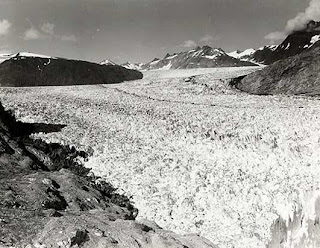Monday, May 12, 2008
Cutting Edge Technology
Cirque du Striae


Thursday, May 1, 2008
Glaci-Nation?
Defined by the Oxford English dictionary as "a period of long-term reduction in the temperature of the Earth's surface and atmosphere", an ice-age is essentially a time during which glaciers cover the ground. It is the period following this ice-age, however, as the temperature begins to rise and the cold weather declines, that these glaciers begin to melt, forming many different and interesting features.

The features formed by glaciers are usually divided into two groups; those formed by glacial erosion and those by glacial deposition.
Features formed by glacial deposition:
1) Drumlin: A drumlin is an oval-shaped hill made of boulder clay, which occur in groups known as 'swarms'. They were formed when boulder clay was deposited by moving glaciers and smoothed into shape as the glacier moved on.
2) Moraine: A moraine is a mound or ridge made of rock, stone, sand and clay that was transported and then deposited by a glacier. Moraines are made of material deposited by a glacier, such as gravel, clay, or sand. There are 4 main types of moraine:
b) Lateral Moraine (at the sides of the glacier)
c) Medial Moraine (in the middle where two glaciers meet)
d) Ground Moraine (covers the valley floor)
3) Erratic: An erratic is a large rock that was picked up by a moving glacier and deposited in another area of a diferent rock type.
4) Boulder Clay Plain: A boulder clay plain is usually a lowland area covered by a mixture of boulders, clay, sand and rocks, all deposited by a melting glacier whose strength and energy was diminishing.
5) Esker: An esker is a narrow ridge made of sand, formed when meltwater streams flowing through the ice became blocked with deposits of rock, clay and sand. These deposits were then left behind after the glacier has melted away.
6) Outwash Plain: Outwash plains are flat areas of snad and gravel, which can be found in front of terminal moraines. They were formed when meltwater spread out from the glacier, carring bits of sand rock and gravel. After a while, however, the flow of water began to lose its energy and so deposited its load.


